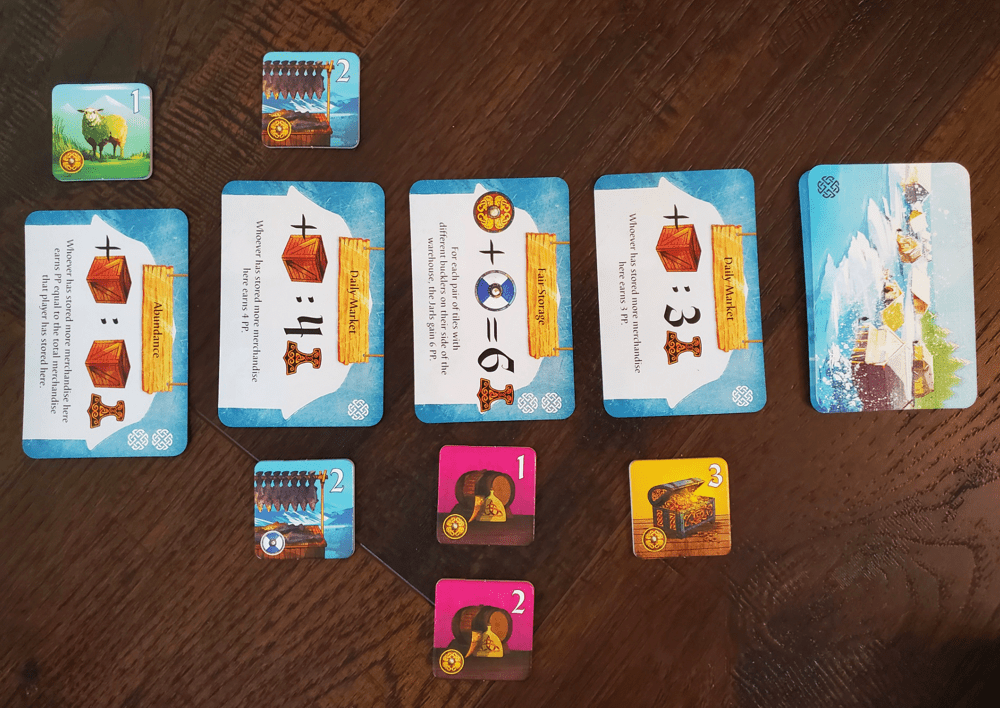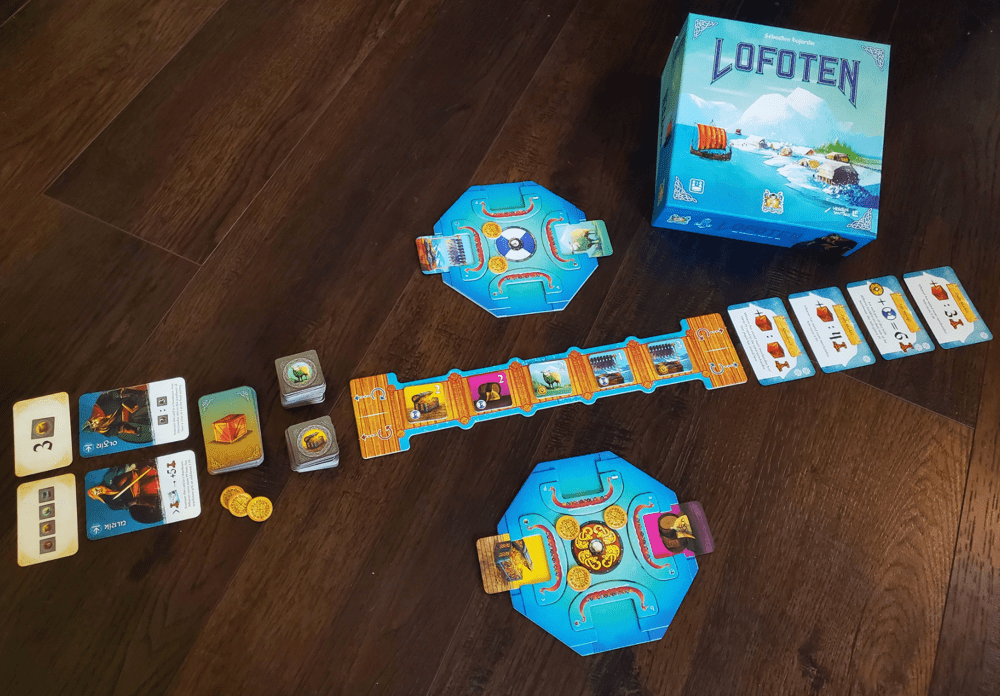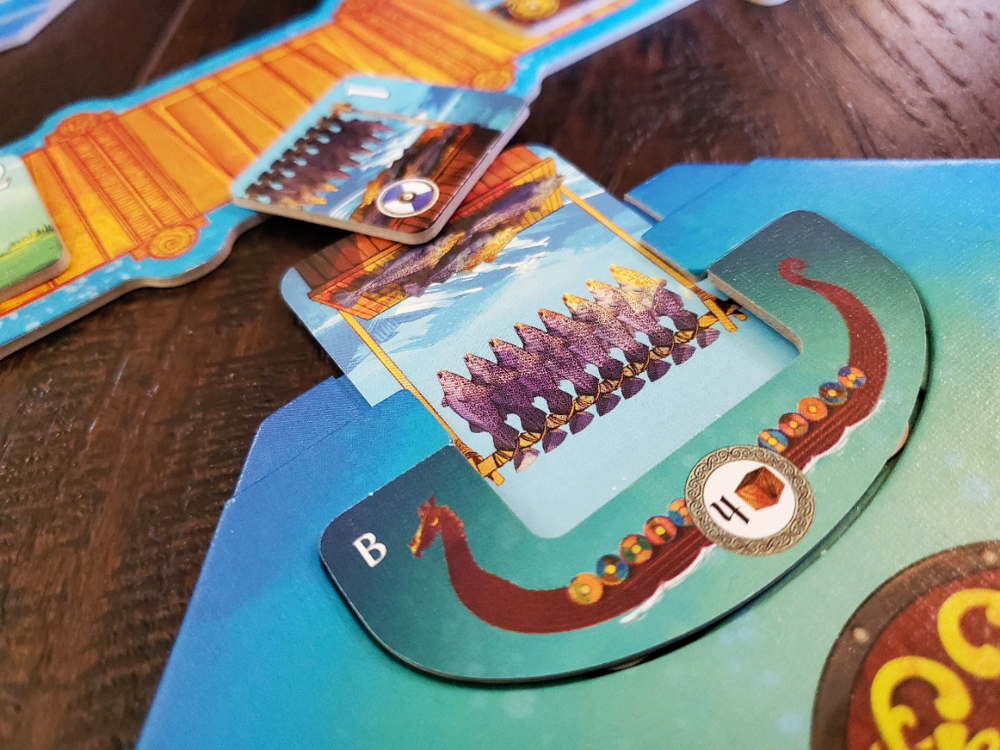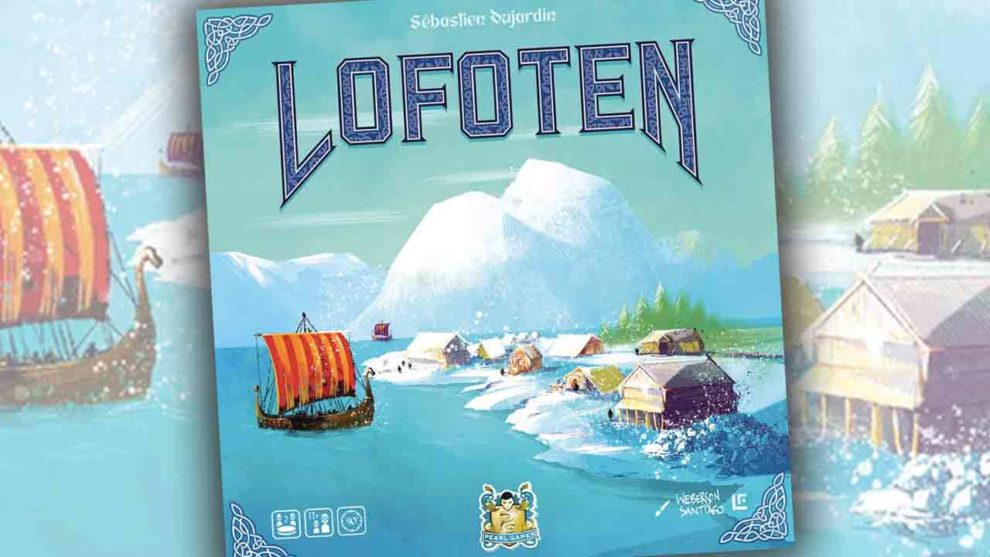Disclosure: Meeple Mountain received a free copy of this product in exchange for an honest, unbiased review. This review is not intended to be an endorsement.
What’s that you say? An octagonal wheel with cards sticking out all around? Ok, I’ll bite. What’s the game. Vikings, you say?
Lofoten is a two-player Viking commerce game from publisher Pearl Games and designer Sébastien Dujardin (Troyes, Deus). I’d be lying if I said I grabbed this game for anything other than its unusual table presence. The component layout divides the table in half, and each player’s space is dominated by the aforementioned octagon. But is there a game to match the novelty?
Mostly, yes? Join me for a look.
Rollin’
‘Round the archipelago of Lofoten, each player receives a fleet wheel—an oversized octagon with longships depicted in the four cardinal directions. For each boat there is a slot that holds a card indicating which goods the boat is currently collecting. These fleet wheels then travel back and forth along the Market row, rotating to align with the five available docks. When a card faces a matching good, that good jumps on board. When the good then faces the player, it moves to one of four Warehouses, represented by cards set to the side.
Each of the four Warehouses contains a scoring rule that will apply to the goods stored there. Only one good can be stored in each Warehouse, so as players place the first good, they are determining the contents for both players. Many of the cards only grant a variety of points to the player with the most goods stored in the location.

Throughout the game players manage a hand of three cards which can never change position once added. Each turn consists of playing a single card. Cards from the left or right cause movement of the fleet wheel, which can include both horizontal sliding and rotating to match the side from which they were played. Cards from the center must be loaded into the slot facing the player before triggering an ability according to the good depicted. Sheep allow lateral fleet movement, Fish allow rotation, Gold grants gold, and Mead allows for the discard of tiles from the Market. Each action occurs as many times as there are matching tiles in the Warehouse (with a minimum of 1).
If at any time during movement and rotation a boat’s card lines up with a good tile, the good is loaded automatically. Unloading is equally instantaneous. This results in a constant flow of goods in and goods out, of loading cards and moving about.
Playing a card is followed by drawing back up to three, placing the new draw on either the left or the right. If a tile left the Market, a new one is then added from one of two stacks where the good type is visible, but not the quantity value of the tile.

Coins are used to purchase boosts. As they are gained, they come from a small central pool of only seven. In the event of an empty pool, stealing from an opponent makes up the difference. During play, one coin buys an extra movement for a left/right card play. Two buy a new hand of cards. Three buy an extra turn. Coins are useful.
When the Market can no longer be refreshed, the game ends once players have each had an equal number of turns.
Rollin’
As it turns out, Lofoten plays at about 75% out of the box. Three modules provide the remainder of the game’s intended balance.
The Warehouse module adds a few extra scoring cards that, quite honestly, I never realized were separate. None of the cards are complicated. From the very first we shuffled the whole lot and played. The key difference is the inclusion of the buckler icons in scoring conditions. The good tiles each contain one of the player bucklers (shields), allowing for the collection of goods according to yet another set of criteria.
Module two adds a small deck of Jarl cards—vikings that alter the Warehouse situation through unique abilities. One might seal off a particular Warehouse, forcing future goods into the other locations. Another might provide a scoring boost to the winner of a specific Warehouse. In game, each of the two available Jarls are given a random condition card that determines the requirements to unleash their effects. Each player is able to claim and employ one.
Module three involves upgrading the four longships on the fleet wheel. Upgrades are purchased by flipping tiles that have already been delivered to the Warehouse. Flipping results in negating the front side of the tile, turning it into a value of one (which doesn’t hurt nearly as bad when the value is already one). There are a few endgame points waiting based on the number of upgrades as well.
In total, these modules add almost no time to the game. Rather, they add a layer of simple decisions. The Jarls sit there under pressure like a mousetrap waiting to spring. The longship upgrades take a split second when the right tile is in the right place at the right time.
Rollin’ on the Vestfjorden
From this point on, I will be speaking of the 100% version of Lofoten, as there is no reason not to include all of the materials from the first play.

When dealing in the genre of dexterity games like Kabuto Sumo or children’s games like so many published by HABA, certain expectations are placed on the components. Every so often, though, a game comes along outside those genres that is almost too heavily dependent on one or more physical components. I think of games like Four Gardens or Disney’s Big Thunder Mountain Railroad. These games take a risk by attempting to place a more traditional set of mechanics in the balance with a less reliable piece of plastic or cardboard.
Where I struggle most with Lofoten is in the execution of the fleet wheel. Don’t get me wrong, the cardboard is sturdy—a tripled layer of thin cardboard to create the insets for the good cards and the recesses for the longship tokens marking each slot. But this game most unfortunately lives and dies by the movement of that octagon, and I can’t say it’s without issues.
Because it doesn’t rotate on a physical axis (it just sits flat on the table) it doesn’t spin evenly, meaning it almost takes two hands to move it around to keep it from hitting the Market. Because the awkwardly shaped longship tokens are loose (they need to be to flip over upon upgrade) they occasionally pop out of place. These are mere annoyances, but the personality of Lofoten is in the movement of that wheel. The game can’t afford annoyances—not here. I keep trying to envision a setup that solves the problem—a cardboard base with a button for spinning, a smooth plastic base that lets the wheel slide and spin on a peg—but I can’t figure it out.

I call this unfortunate because Lofoten has an interesting gameplay arc. Having the outcome depend upon only four scoring conditions is a tight and risky design choice. Every game involves a constant action and reaction with the availability of tiles, the unchangeable splay of cards in the hand, the unique combo of Warehouse cards, and the Jarls. Knowing that every action feeds only a handful of comparisons that determine the entire outcome can be quite tense. If the fleet wheel could walk a straight line without undue effort, there is something here to get lost in.
The card play is most intriguing in the draw. Remember draws can only be placed to the left or right. Now imagine you want the card on the right to be in the middle. You have to play the left card, then reload on the right to reposition the card to its desired location. Of course, you also have to hope that the left card is useful and that the reload will find a useful home on the right. Once the cards are in hand, the play is often a foregone conclusion—unless your opponent suddenly discards the tile you were fixin’ to claim.
Upgrading the longships usually introduces a tough decision or two as well. Flipping a tile often means sacrificing a quantity of goods or a needed buckler in a given Warehouse. While the boats do grant scoring bonuses, the lost tiles must be chosen wisely and at opportune moments.
Each game, which hovers a bit over 30 minutes, will contain a handful of satisfying combos. With a proper bit of forethought, it’s possible to employ a three-card and a coin to move-spin-move-spin, collecting two goods and unloading two others. It is extremely gratifying when smooth turns come together. Likewise, pulling off a precise loading and unloading with the final turn to shift the balance of a Warehouse or two will be memorable. Lofoten has more than a few flashes of potential.
But Lofoten is also loaded with question marks beyond the wheel. The Jarl cards are mostly solid, but some introduce effects that, while interesting, aren’t entirely useful by the time the condition is met for getting it into the game. Some are downright Herculean in their scoring effect. I feel as though the game needs something like the Jarls, but that they are a bit erratic.
And speaking of erratic, Lofoten occasionally ends a few rounds early. Because the Warehouse contents are visible, the outcome is occasionally obvious and unavoidable. If there are three all-or-none scoring conditions among the four, and even two are all but settled, I have to ask if it isn’t better to simply concede and start the next game. Perhaps this is OK, but in a relatively short dueling game, I wish it weren’t the case.
Overall, there are just enough hiccups to slide Lofoten down a tier among the two-player games in our household. However, I’m happy to have spent some time with the Viking-folk and may yet introduce the game to some friends. There are compelling ideas here for those who aren’t as miffed by the fidgety fleet wheel and the potential imbalances looming in the shadows. If you have a favorite partner with whom you evenly match wits, you might find something here to celebrate.











